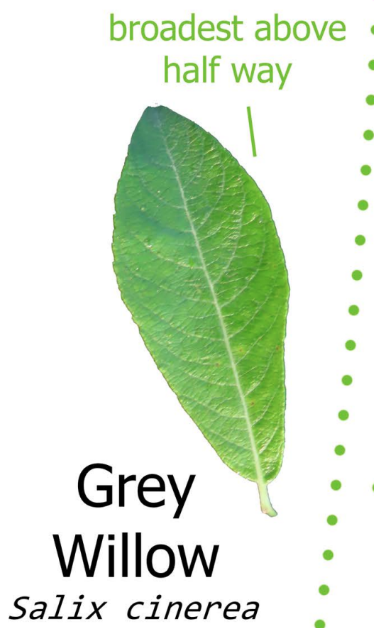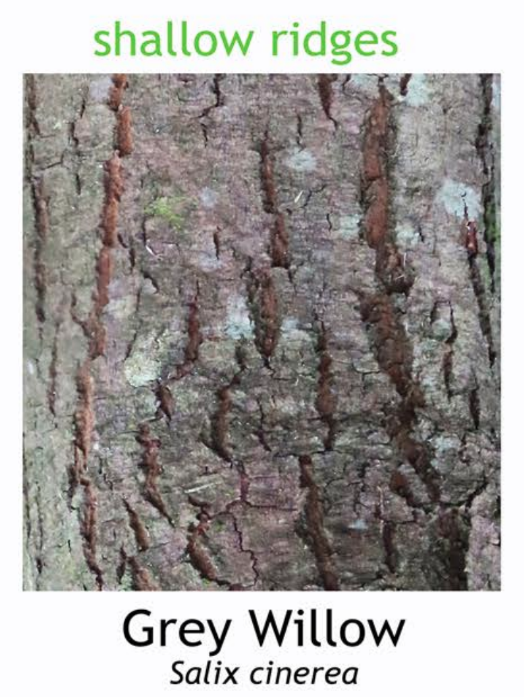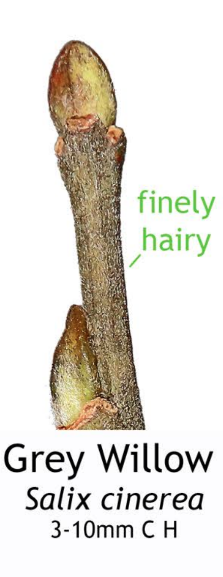A native deciduous tree species in Ireland, commonly found in wetland habitats, along riverbanks, and in damp woodlands.
Recognising the Grey Willow Tree:
-
Leaves: The leaves of the Grey Willow tree are alternate, lanceolate to ovate in shape, and have serrated margins. They are greyish-green in colour and have a hairy or pubescent underside.
-
Bark: The bark of the Grey Willow tree is smooth and greyish-brown when young, becoming rougher and more fissured with age. It may develop a reddish tinge on older branches and trunks.
-
Catkins: Grey Willow trees produce catkins in early spring before the leaves emerge. The catkins are cylindrical in shape and appear in clusters on separate male and female trees. Male catkins are longer and more slender, while female catkins are shorter and more compact.
-
Habitat: Grey Willow trees are commonly found in wetland habitats, including marshes, fens, bogs, and riparian zones. They are often associated with other wetland species and can tolerate waterlogged soils and periodic flooding.
-
Shape: Grey Willow trees have a shrubby or small tree-like growth habit, with multiple stems arising from the base. They can grow to heights of 3-6 meters, depending on environmental conditions and growing conditions.



5 Interesting Facts about the Grey Willow Tree:
-
Rapid Growth: Grey Willow trees are fast-growing species, capable of reaching maturity within a relatively short period. Their rapid growth rate makes them valuable for habitat restoration projects and erosion control efforts in wetland habitats and riparian zones.
-
Habitat Specialist: Grey Willow trees are well adapted to thrive in wetland habitats and are often found growing along riverbanks, streams, and in marshy areas. Their tolerance for waterlogged soils and periodic flooding makes them important species for stabilising riverbanks and preventing erosion.
-
Wildlife Habitat: Grey Willow trees provide valuable habitat and food for a variety of wildlife species. The catkins are an important early food source for pollinators such as bees and butterflies, while the foliage provides shelter and nesting sites for birds and small mammals.
-
Hybridisation: Grey Willow trees have the ability to hybridise with other willow species, resulting in a diverse array of hybrids with varying characteristics. This hybridisation contributes to the genetic diversity of willow populations and may result in new combinations of traits suited to specific environmental conditions.
-
Traditional Uses: Various parts of the Grey Willow tree have been used historically for medicinal, culinary, and practical purposes. Willow bark contains compounds known as salicylates, which have pain-relieving and anti-inflammatory properties and have been used to make traditional remedies such as willow bark tea.
Uses of the Grey Willow Tree:
-
Erosion Control: Grey Willow trees help stabilise soil and prevent erosion in wetland habitats, riverbanks, and riparian zones. Their extensive root systems help bind soil particles together and reduce the impact of water flow, making them valuable for erosion control and habitat restoration.
-
Wildlife Habitat: Grey Willow trees provide valuable habitat and food for a variety of wildlife species, including birds, mammals, insects, and amphibians. The catkins are an important early food source for pollinators, while the foliage provides shelter and nesting sites for birds and small mammals.
-
Woodland Planting: Grey Willow trees are sometimes planted in woodland and hedgerow habitats to provide habitat diversity and enhance biodiversity. They can be used to create wildlife corridors, buffer zones, and riparian buffers, providing valuable habitat and food resources for wildlife species in diverse landscapes.
Contribution to Biodiversity:
-
Habitat Provider: Grey Willow trees contribute to biodiversity by providing habitat and food for a wide range of wildlife species in wetland habitats, riparian zones, and woodland ecosystems. Their catkins are an important early food source for pollinators, while their foliage provides shelter and nesting sites for birds and small mammals.
-
Erosion Control: Grey Willow trees help stabilise soil and prevent erosion in wetland habitats and riparian zones. Their extensive root systems help bind soil particles together and reduce the impact of water flow, contributing to the health and stability of riverbanks and riparian ecosystems.
-
Water Quality Improvement: Grey Willow trees play a role in improving water quality in wetland habitats by filtering pollutants, reducing sedimentation, and absorbing excess nutrients from runoff. Their presence helps maintain the ecological integrity of wetland ecosystems and supports diverse populations of aquatic and terrestrial species.
In summary, the Grey Willow tree is recognisable by its greyish-green leaves, smooth greyish-brown bark, cylindrical catkins, and shrubby growth habit. It holds cultural significance, provides valuable resources for wildlife, and contributes to biodiversity and ecosystem health in Ireland's wetland habitats, riparian zones, and woodland ecosystems.
Images taken from the beautiful posters created by Phil Barnett and you can download these and/or purchase other great designs from his online shop.
